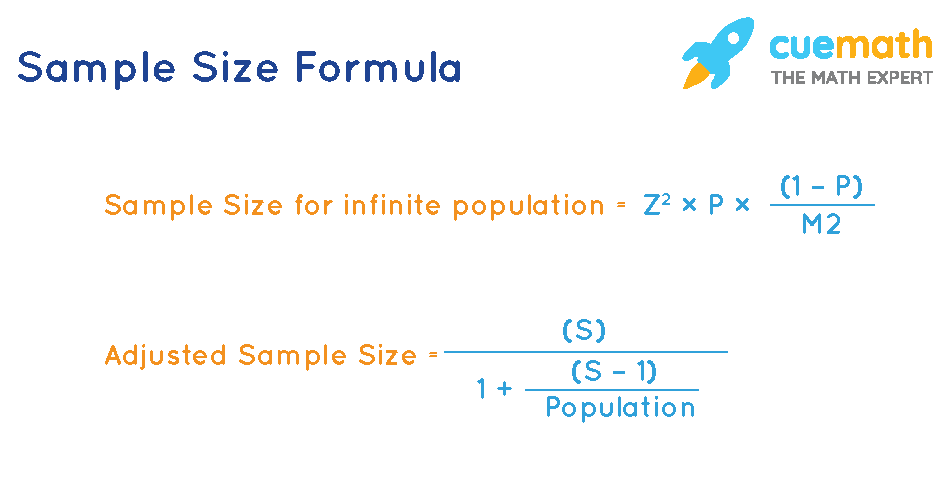
The sample size formula helps us find the accurate sample size through the difference between the population and the sample. To recall, the number of observations in a given sample population is known as sample size. Since it not possible to survey the whole population, we take a sample from the population and then conduct a survey or research. The sample size is denoted by “n” or “N”. Here, it is written as “SS”. Let us learn the sample size formula along with a few solved examples.
The sample size formula is determined in two steps. First, we calculate the sample size for the infinite population and second we adjust the sample size to the required population. The sample size formula can be given as:
Formula 1: Sample size for infinite population
S= Z 2 × P × \(\dfrac\)
Formula 2: Adjusted sample size
Note: Z score is determined based on the confidence level.
Confidence Level: Probability that the value of a parameter falls within a specified range of values. For example, for 95% confidence level Z score is 1.960. The margin of error: It is defined as a small amount that is allowed for in case of miscalculation or change of circumstances. Generally, the margin of error is taken as 5% or 0.05.

In order to calculate the required sample size, we need to find several other sets of values and then substitute them into an appropriate formula. Let's look at the steps to be followed to calculate the sample size.
Step 1: Determining Key Values
One of the key values to be determined is the population size which refers to the total number of people within the required demographic. For much larger studies, we can consider using an approximated value instead of using a precise number.
Step 2: Determining the margin of error or confidence interval
The margin of error is considered to be the amount of error that can be allowed in the study. The margin of error is actually a percentage that shows how close the sample results will be with respect to the true value of the overall population that is considered in the study.
For instance, 35% of people choose option B, with a margin of error of +/- 5%". In this particular example, the margin of error actually indicates that, if the question was asked to the entire population, then you are confident that between 30% (35 - 5) and 40% (35 + 5) of the people will agree with option B.
Step 3: Setting the confidence level.
The confidence level is pretty closely related to the margin of error or confidence interval. This value is used to measure the degree of certainty about how well a sample actually represents the entire population within the margin of error chosen for the study.
Step 4: Specifying the standard of deviation.
The standard of deviation shows how much variation can be expected from the responses of the study.
Since this value is difficult to be calculated in an actual survey, most people choose to use 0.5 (50%) as the value which is actually the worst-case scenario percentage. Thus, using this value will actually guarantee that the calculated sample size is huge enough to show the overall population within the confidence level and the confidence interval in an accurate manner.
Step 5: Finding the Z-score.
The Z-score can be considered as a constant value that is set automatically depending on the confidence level. Z-score shows the number of standard deviations or the standard normal score between the average/mean of the population and any selected value.
Z-score is very easy to calculate that one can do it with their hand, or find an online calculator.
Due to the fact that the confidence levels are all standardized, most researchers actually memorize the required z-score for most of the commonly used confidence levels:
| Confidence Level | Z-score |
| 80% | 1.28 |
| 85% | 1.44 |
| 90% | 1.65 |
| 95% | 1.96 |
| 99% | 2.58 |
Lets' look at the below-given equation. If the size of the population is small to moderate, then it is easier to know all the key values and thus the standard formula can be used. The standard formula for calculating the sample size is:
Sample Size Formula = [z 2 * p(1-p)] / e 2 / 1 + [z 2 * p(1-p)] / e 2 * N]
Let's provide the required values specific to the survey in this standard formula. Consider the example of determining the ideal survey size for a population size of 425 people. Let's use these:
Let us see how to use the sample size formula in the following solved examples section.

Become a problem-solving champ using logic, not rules. Learn the why behind math with our certified experts
Example 1: Calculate the sample size for a population of 100000. Take confidence level as 95% and margin of error as 5%.
Solution:
To find: Sample size for 100000 population.
We will calculate the sample size first by calculating it for infinite size and then adjusting it to the required size.
Given: Z = 1.960, P = 0.5, M = 0.05
Using sample size formula,
= 3.8416 × 0.25 / 0.0025
S = 384.16
Answer: The sample size for the infinite population is 384.16
Example 2 : Using the sample size formula, adjust the sample size for the required population in solved example 1.
Solution:
To Find: Adjusted sample size.
Given: Z = 1.960, P =0.5, M = 0.05
Using sample size formula for adjusted sample size ,
= 382.69 or
= 383 approx.
Answer: The required sample size for a population of 100000 is 383.
Example 3: Using the Sample Size Formula, find the sample size for a survey where confidence level = 95%, standard deviation = .5, and margin of error = +/- 5%.
Solution:
The Sample Size can be calculated as = (Z-score) 2 * SD*(1-SD) / (margin of error) 2
= ((1.96) 2 x .5(.5)) / (.05) 2
= (3.8416 x .25) / .0025
Thus, you will be needing 385 respondents for this survey.
As per the sample size formula, the sample size for infinite population: S = Z 2 × P × \(\dfrac\)
In the sample size formula, the Z score is determined based on the confidence level. Z-score is a numerical measurement used to describe a value's relationship to the mean of a group of values. Z-score is measured in terms of standard deviations of values from their mean.
Slovin's formula differs from the sample size formula in this way: it allows us to sample the population with a desired degree of accuracy. It gives an idea of how large the sample size needs to be to ensure reasonable accuracy of results.
The size of the sample is very important for getting accurate and statistically significant results. The sample size for an infinite population is calculated as S= Z 2 × P × \(\dfrac\)